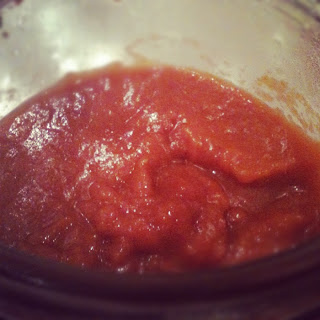 |
| Fish, Chips & Mushy Peas |
So I've had this deep-fat fryer for six and a bit years – willingly bought with wedding vouchers if you must know – and I've never used it. It's one of those mini industrial-looking ones and really called out to me to buy it when I first saw it. If I wasn't with my wife of a couple of weeks at the time I would probably have eloped. Now, I don't really understand what was behind this odd infatuation. Sure, I like chips, who doesn't, but frying your own just seems so antiquated. I mean, there's nothing wrong with oven chips – less fat, less smell, less chance of burning your house down – and if I really wanted that authentic "Chip Shop Experience", I'd go to, wait for it, the chip shop. So there it sat, first gleaming along with other newly bought appliances on the worktops, then in its box, then in its box under the stairs. Until last Saturday, that is, when it was unearthed in preparation for my first foray into chip frying.
The first thing was to fill the bugger (oh, how fickle love is) with the minimum four litres of sunflower oil. Four litres. Four. Litres. The second was to do some research into cooking the perfect chip. What potato, what oil (damn, should have read this first), twice fry, thrice fry (Heston being his usual "must outdo everyone else" self. Only surprised he didn't inject each chip with chicken liver parfait), to parboil or not. The third was what accompaniment. Gotta be fish, and for my debut I really wanted to cook cod as that is the daddy. But isn't it endangered or something? Maybe I should go for something else. Haddock? Pollock? Bollocks. Tough titty, my fishy friend, I'd buy sustainable, line-caught cod to ease my tortured conscience and chuck a quid into the next Greenpeace collection I see.
Oh, and then there's the batter. Gotta be beer, but which beer? Does it even matter? And you must have mushy peas as well. By now I was seriously considering giving up and heading off to the nearest chippie to drown my sorrows in a vat of vinegar. But no, one trip to the supermarket later and I was set, six-plus years of pent-up lust about to be unleashed in a torrent of hot oil. Serves 4.
Chips
 |
| Before the first fry |
This is the method I went for. I'm not going to lie, it takes a bit of time and is nothing like whacking a tray of McCains into the oven. The result was pretty good – a lovely golden colour, floury in the middle and slightly crisp. If I'm being fussy, they could have been a bit crispier, so I guess the secret is getting the chips really, really dry after each stage of the process. Instead of sunflower oil you could use dripping or animal fat instead – don't forget I need four litres of the stuff, though. Never going to happen.
Ingredients:
250g Maris Piper potato per person
Method:
1. Peel the potatoes and cut into chips. Soak in a bowl of cold water for 1 hour, then drain.
2. Put the chips into a pan of cold, salted water and bring to the boil. Simmer for a couple of minutes until just soft.
3. Drain, pat dry and allow to cool before putting them in the fridge until cold.
4. Heat your oil to 120C (use a thermometer if you don't have a temperature control) and add the chips in batches. Cook for about 5 minutes until cooked but not coloured.
5. Drain, pat dry and refrigerate again.
6. Heat the oil to 160C and add the chips. Cook until crisp and golden, drain and serve.
Fish
Wow. Just wow. This was amazing and probably the best battered fish I've ever had – and I grew up by the sea so this is saying something. I used a Jamie Oliver recipe for the batter, although I added slightly more of my beer of choice, John Smith's, to get the right consistency. The result after frying was ridiculously crispy, golden batter and perfect, soft fish.
Ingredients:
4 x 225g white fish fillets
1/2 tsp salt
1 tsp black pepper
225g plain flour, plus extra for dusting
285ml cold beer
3 heaped tsp baking powder
Method:
1. Heat the oil to 190C. Season the fish on both sides with salt and pepper and dust each with flour.
2. Whisk the flour, beer and baking powder together until thick and shiny. The texture should be like semi-whipped double cream.
3. Dip the fish into the batter and allow excess to drip off. Carefully lower into the fryer and cook for 4 minutes until golden and crisp.
Mushy Peas
 |
| Mushy Peas |
Another Oliver recipe, very simple.
Ingredients:
knob butter
4 handfuls peas
small handful mint, leaves picked and chopped
squeeze lemon juice
sea salt and ground black pepper
Method:
1. Put the butter in a pan with the peas and mint. Cover and simmer for 10 minutes. Add lemon juice and season. Mash.







































